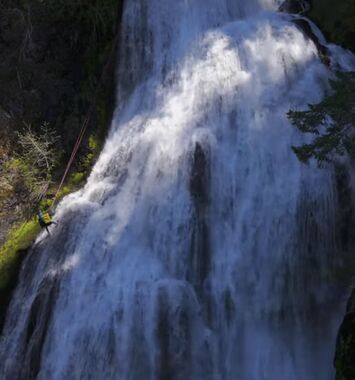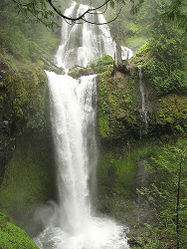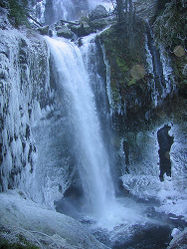Falls Creek Canyoneering Canyoning Caving
|
| Rating: |
Log in to rateLog in to rateLog in to rateLog in to rateLog in to rate 3.6 (6 ratings) |
|

|
| |
Raps:3, max ↨160ft | Overall: | 4h | ⟷3.2mi |
|---|
| | ↑990ft | | ⟷725ft | ↓308ft | | | ↓710ft |
No Shuttle:None |
|---|
| Location: |
|
|---|
| |
|---|
| Condition Reports: |
15 Nov 2025
"Great day at FCF. Big water. I don’t think the reference photos are close to accurate. Probably reversed in flow descriptions. Did the traditional
(log in to submit report)
|
|---|
Weather: |
|
|---|
| Best season: |
Aug-Sept | winter | | spring | | summer | | fall |
|---|
| Dec | Jan | Feb | | Mar | Apr | May | | Jun | Jul | Aug | | Sep | Oct | Nov |
|
| Regions: |
|
https://web.archive.org/web/20210527212206/www.canyoneeringnorthwest.com/FallsCreekFalls/Falls_Creek_Falls.php
https://youtu.be/QDgsfe65JRg?si=swyjENfeE2hsc9h8
45.9057, -121.9401https://ropewiki.com/images/6/6f/Falls_Creek.kmltopo
GPS data automatically extracted from [], please visit their site for more detailed information.
Automatic GPS data extraction NOT allowed, please visit [] to download GPX.
Reference photos

21 Jun 2009:
Very High. Dangerously high water, only for expert swift water canyoneers (class C3 = a6). Did not run.

25 Nov 2007:
Extreme. Extremely dangerous high water, may be unsafe even for experts (class C4 = a7).
These reference pictures are used in the
Waterflow analysis to predict current conditions. More reference pictures will produce a more reliable prediction.
(log in to submit reference picture) | Welcome! Canyons in the Pacific Northwest can be different from those you might be used to. Be ready for unlinked bolts, retrievable traverse lines, and challenging aquatic environments. For more on local practices, and the best way to get started in the region, check out the WCC Safety page.
- Unlinked Bolts - groups should be comfortable rigging unlinked bolts, either temporarily linking them for all but the last person, or using a passive redundancy method. Most importantly, if you find two bolts side by side that are unlinked, do not add webbing to them. Linking bolts designed to be unlinked will likely cause damage during seasonal floods.
- Traverse Lines - many canyons are rigged to allow traverse line access to an exposed anchor station. This should be done using self-belay or team belay techniques. Do not leave fixed lines in the canyons.
- Challenging Environments - the highly aquatic nature of PNW canyons can surprise many. Cold temperatures, slippery rocks, loud waterfalls, and strong currents all lead to unexpected problems. Do not underestimate the need for strong team work and technical proficiency. Belays are frequently not possible. Unattended gear will sink or float away. Sliding and jumping is the cause of most major injuries, so it's critical to effectively communicating water depth & submerged hazards.
|
Introduction[edit]
A massive three-tier waterfall draining the southwest side of the Indian Heaven plateau. One of the most impressive waterfalls close to Portland, OR. Expect high flow even late into the season. Frequently visited by non-canyoneer tourists.
Approach[edit]
Descent[edit]
R1 110' DCR tree
R2 160' DCR tree
R3 110' DCL boulder (rappel ends at shelf DCL of the pool)
Red tape[edit]
Things may be changing, but as of 2019, canyoning is still a new sport in the Pacific NW. Unlike other parts of the country (ex: the Colorado Plateau), canyoning is not widely known or recognized here. Individuals climbing, rappelling, or slack-lining around "show waterfalls" (such as Falls Creek Falls) are far more likely to garner negative reactions from the public at large. Negative reactions lead to complaints and more rules by the local authorities. Locals suggest running such falls during the off-season and on weekdays when numbers of other visitors will be low.
Beta sites[edit]
Trip reports and media[edit]
2025
https://youtu.be/QDgsfe65JRg?si=swyjENfeE2hsc9h8
Background[edit]
 CanyoneeringNorthwest.com (archive.org) : Falls Creek Falls
CanyoneeringNorthwest.com (archive.org) : Falls Creek Falls

